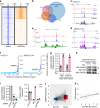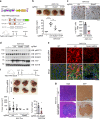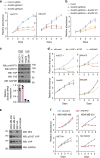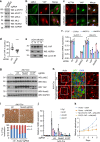NUAK2 is a critical YAP target in liver cancer
- PMID: 30446657
- PMCID: PMC6240092
- DOI: 10.1038/s41467-018-07394-5
NUAK2 is a critical YAP target in liver cancer
Abstract
The Hippo-YAP signaling pathway is a critical regulator of proliferation, apoptosis, and cell fate. The main downstream effector of this pathway, YAP, has been shown to be misregulated in human cancer and has emerged as an attractive target for therapeutics. A significant insufficiency in our understanding of the pathway is the identity of transcriptional targets of YAP that drive its potent growth phenotypes. Here, using liver cancer as a model, we identify NUAK2 as an essential mediator of YAP-driven hepatomegaly and tumorigenesis in vivo. By evaluating several human cancer cell lines we determine that NUAK2 is selectively required for YAP-driven growth. Mechanistically, we found that NUAK2 participates in a feedback loop to maximize YAP activity via promotion of actin polymerization and myosin activity. Additionally, pharmacological inactivation of NUAK2 suppresses YAP-dependent cancer cell proliferation and liver overgrowth. Importantly, our work here identifies a specific, potent, and actionable target for YAP-driven malignancies.
Conflict of interest statement
The authors declare no competing interests.
Figures





Similar articles
-
A feed forward loop enforces YAP/TAZ signaling during tumorigenesis.Nat Commun. 2018 Aug 29;9(1):3510. doi: 10.1038/s41467-018-05939-2. Nat Commun. 2018. PMID: 30158528 Free PMC article.
-
Induction of Chromosome Instability by Activation of Yes-Associated Protein and Forkhead Box M1 in Liver Cancer.Gastroenterology. 2017 Jun;152(8):2037-2051.e22. doi: 10.1053/j.gastro.2017.02.018. Epub 2017 Feb 27. Gastroenterology. 2017. PMID: 28249813
-
TAZ target gene ITGAV regulates invasion and feeds back positively on YAP and TAZ in liver cancer cells.Cancer Lett. 2020 Mar 31;473:164-175. doi: 10.1016/j.canlet.2019.12.044. Epub 2020 Jan 3. Cancer Lett. 2020. PMID: 31904487
-
Role of the transcriptional coactivators YAP/TAZ in liver cancer.Curr Opin Cell Biol. 2019 Dec;61:64-71. doi: 10.1016/j.ceb.2019.07.006. Epub 2019 Aug 3. Curr Opin Cell Biol. 2019. PMID: 31387016 Review.
-
Targeting YAP and Hippo signaling pathway in liver cancer.Expert Opin Ther Targets. 2010 Aug;14(8):855-68. doi: 10.1517/14728222.2010.499361. Expert Opin Ther Targets. 2010. PMID: 20545481 Review.
Cited by
-
Dysregulation of the ESRP2-NF2-YAP/TAZ axis promotes hepatobiliary carcinogenesis in non-alcoholic fatty liver disease.J Hepatol. 2021 Sep;75(3):623-633. doi: 10.1016/j.jhep.2021.04.033. Epub 2021 May 6. J Hepatol. 2021. PMID: 33964370 Free PMC article.
-
Controversies Surrounding the Origin of Hepatocytes in Adult Livers and the in Vitro Generation or Propagation of Hepatocytes.Cell Mol Gastroenterol Hepatol. 2021;11(1):273-290. doi: 10.1016/j.jcmgh.2020.09.016. Epub 2020 Sep 28. Cell Mol Gastroenterol Hepatol. 2021. PMID: 32992051 Free PMC article. Review.
-
Targeting tumor-associated macrophages and granulocytic myeloid-derived suppressor cells augments PD-1 blockade in cholangiocarcinoma.J Clin Invest. 2020 Oct 1;130(10):5380-5396. doi: 10.1172/JCI137110. J Clin Invest. 2020. PMID: 32663198 Free PMC article.
-
The Effect of Fibroblast Growth Factor 15 Signaling in Non-Steatotic and Steatotic Liver Transplantation from Cardiocirculatory Death.Cells. 2019 Dec 14;8(12):1640. doi: 10.3390/cells8121640. Cells. 2019. PMID: 31847428 Free PMC article.
-
The Hippo Pathway in Liver Homeostasis and Pathophysiology.Annu Rev Pathol. 2021 Jan 24;16:299-322. doi: 10.1146/annurev-pathol-030420-105050. Epub 2020 Nov 24. Annu Rev Pathol. 2021. PMID: 33234023 Free PMC article. Review.
References
Publication types
MeSH terms
Substances
Grants and funding
LinkOut - more resources
Full Text Sources
Other Literature Sources
Medical
Molecular Biology Databases
Research Materials

